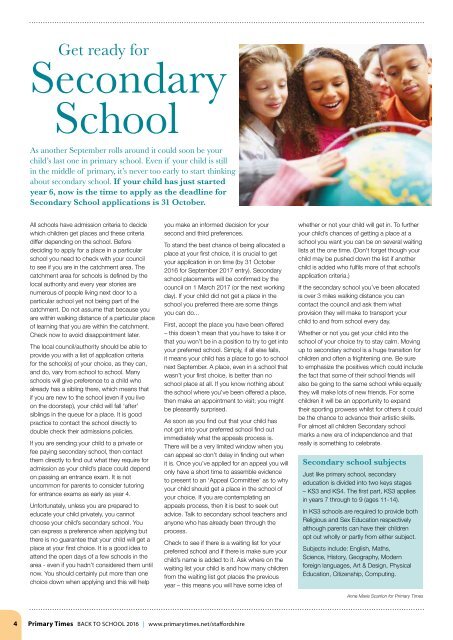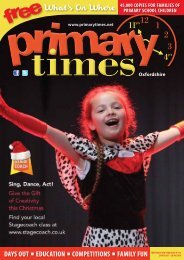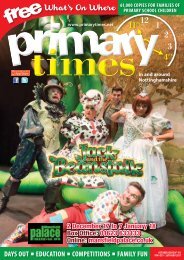Create successful ePaper yourself
Turn your PDF publications into a flip-book with our unique Google optimized e-Paper software.
Get ready for<br />
Secondary<br />
<strong>School</strong><br />
As another September rolls around it could soon be your<br />
child’s last one in primary school. Even if your child is still<br />
in the middle of primary, it’s never too early to start thinking<br />
about secondary school. If your child has just started<br />
year 6, now is the time to apply as the deadline for<br />
Secondary <strong>School</strong> applications is 31 October.<br />
All schools have admission criteria to decide<br />
which children get places and these criteria<br />
differ depending on the school. Before<br />
deciding to apply for a place in a particular<br />
school you need to check with your council<br />
to see if you are in the catchment area. The<br />
catchment area for schools is defined by the<br />
local authority and every year stories are<br />
numerous of people living next door to a<br />
particular school yet not being part of the<br />
catchment. Do not assume that because you<br />
are within walking distance of a particular place<br />
of learning that you are within the catchment.<br />
Check now to avoid disappointment later.<br />
The local council/authority should be able to<br />
provide you with a list of application criteria<br />
for the school(s) of your choice, as they can,<br />
and do, vary from school to school. Many<br />
schools will give preference to a child who<br />
already has a sibling there, which means that<br />
if you are new to the school (even if you live<br />
on the doorstep), your child will fall ‘after’<br />
siblings in the queue for a place. It is good<br />
practice to contact the school directly to<br />
double check their admissions policies.<br />
If you are sending your child to a private or<br />
fee paying secondary school, then contact<br />
them directly to find out what they require for<br />
admission as your child’s place could depend<br />
on passing an entrance exam. It is not<br />
uncommon for parents to consider tutoring<br />
for entrance exams as early as year 4.<br />
Unfortunately, unless you are prepared to<br />
educate your child privately, you cannot<br />
choose your child’s secondary school. You<br />
can express a preference when applying but<br />
there is no guarantee that your child will get a<br />
place at your first choice. It is a good idea to<br />
attend the open days of a few schools in the<br />
area - even if you hadn’t considered them until<br />
now. You should certainly put more than one<br />
choice down when applying and this will help<br />
you make an informed decision for your<br />
second and third preferences.<br />
To stand the best chance of being allocated a<br />
place at your first choice, it is crucial to get<br />
your application in on time (by 31 October<br />
<strong>2016</strong> for September 2017 entry). Secondary<br />
school placements will be confirmed by the<br />
council on 1 March 2017 (or the next working<br />
day). If your child did not get a place in the<br />
school you preferred there are some things<br />
you can do...<br />
First, accept the place you have been offered<br />
– this doesn’t mean that you have to take it or<br />
that you won’t be in a position to try to get into<br />
your preferred school. Simply, if all else fails,<br />
it means your child has a place to go to school<br />
next September. A place, even in a school that<br />
wasn’t your first choice, is better than no<br />
school place at all. If you know nothing about<br />
the school where you’ve been offered a place,<br />
then make an appointment to visit; you might<br />
be pleasantly surprised.<br />
As soon as you find out that your child has<br />
not got into your preferred school find out<br />
immediately what the appeals process is.<br />
There will be a very limited window when you<br />
can appeal so don’t delay in finding out when<br />
it is. Once you’ve applied for an appeal you will<br />
only have a short time to assemble evidence<br />
to present to an ‘Appeal Committee’ as to why<br />
your child should get a place in the school of<br />
your choice. If you are contemplating an<br />
appeals process, then it is best to seek out<br />
advice. Talk to secondary school teachers and<br />
anyone who has already been through the<br />
process.<br />
Check to see if there is a waiting list for your<br />
preferred school and if there is make sure your<br />
child’s name is added to it. Ask where on the<br />
waiting list your child is and how many children<br />
from the waiting list got places the previous<br />
year – this means you will have some idea of<br />
whether or not your child will get in. To further<br />
your child’s chances of getting a place at a<br />
school you want you can be on several waiting<br />
lists at the one time. (Don’t forget though your<br />
child may be pushed down the list if another<br />
child is added who fulfils more of that school’s<br />
application criteria.)<br />
If the secondary school you’ve been allocated<br />
is over 3 miles walking distance you can<br />
contact the council and ask them what<br />
provision they will make to transport your<br />
child to and from school every day.<br />
Whether or not you get your child into the<br />
school of your choice try to stay calm. Moving<br />
up to secondary school is a huge transition for<br />
children and often a frightening one. Be sure<br />
to emphasize the positives which could include<br />
the fact that some of their school friends will<br />
also be going to the same school while equally<br />
they will make lots of new friends. For some<br />
children it will be an opportunity to expand<br />
their sporting prowess whilst for others it could<br />
be the chance to advance their artistic skills.<br />
For almost all children Secondary school<br />
marks a new era of independence and that<br />
really is something to celebrate.<br />
Secondary school subjects<br />
Just like primary school, secondary<br />
education is divided into two keys stages<br />
– KS3 and KS4. The first part, KS3 applies<br />
in years 7 through to 9 (ages 11-14).<br />
In KS3 schools are required to provide both<br />
Religious and Sex Education respectively<br />
although parents can have their children<br />
opt out wholly or partly from either subject.<br />
Subjects include: English, Maths,<br />
Science, History, Geography, Modern<br />
foreign languages, Art & Design, Physical<br />
Education, Citizenship, Computing.<br />
Anne Marie Scanlon for <strong>Primary</strong> <strong>Times</strong><br />
4<br />
<strong>Primary</strong> <strong>Times</strong> BACK TO SCHOOL <strong>2016</strong> | www.primarytimes.net/staffordshire

















